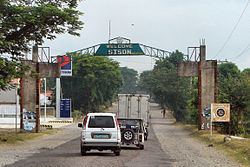Country Philippines Founded December 14, 1862 Time zone PST (UTC+8) Local time Thursday 9:42 AM | Region Ilocos (Region I) Barangays Area 81.88 km² Province Pangasinan | |
 | ||
District 5th district of Pangasinan Weather 31°C, Wind S at 6 km/h, 61% Humidity | ||
Sison pangasinan phantom 4 footage
Sison (Pangasinan: Baley na Sison; Ilocano: Ili ti Sison), is a 3rd class municipality in the province of Pangasinan, Philippines. According to the 2015 census, it has a population of 47,518 people.
Contents
- Sison pangasinan phantom 4 footage
- Map of Sison Pangasinan Philippines
- Antong falls adventure sison pangasinan
- Geography
- History
- Municipal government
- Tourism
- Diocesan Shrine of Our Lady of Mount Carmel
- References
Map of Sison, Pangasinan, Philippines
Sison was once part of San Fabian until petitioners from Barrio Bolaoen signed a manifesto in June 30, 1858 expressing their intention of creating a separate pueblo. It was filed to the Governadorcillo of San Fabian and was later endorsed to the Alcalde Mayor of Lingayen in August 8, 1858. After the definition of the jurisdiction of the proposed new pueblo, the administrative proceedings began with the mayor of San Fabian himself, Don Enrique Casaoay, as among those who appeared in behalf of the petitioners. On December 15, 1862, a royal decree was finally issued declaring the creation of a pueblo independent of San Fabian’s civil jurisdiction. The pueblo was called Alava. Don Faustino Baclit served as its ad interim head until the pueblo’s first elected president, Don Felix Genelazo, assumed his office on March 1, 1868. Under the following American regime, a bill effecting the incorporation of Artacho to Alava was approved on March 25,1918 through the sponsorship of Senator Pedro Ma. Sison. Following this incorporation, Alava was renamed Sison in honor of Don Perfecto Sison, first provincial governor of Pangasinan.
Antong falls adventure sison pangasinan
Geography
It is geographically located on the northern portion of Pangasinan, bordering the provincial boundaries of La Union and Benguet. It has a total land area of 81.88 square kilometers. It is bounded on the north by Rosario (La Union), Tuba (Benguet); on the south by Pozorrubio; on the southeast by San Manuel and Binalonan; on the west by San Fabian .
The municipality is 207 kilometres (129 mi) north of Manila, 62 kilometres (39 mi) south of San Fernando City, where the regional office of the national government agencies in Region I are located, 70 kilometres (43 mi) east of Lingayen, the provincial capital, and 43 kilometres (27 mi) south of Baguio City.
History
Sison originated from San Fabian, that is, from Bulaoen, then into Alava in 1862 and finally to Poblacion, the present site. In 1907, Esperanza, north-east of Alava, was formed into Pinmilapil, Agat, Sagunto, Cauringan, Bila and Colisao (now in San Fabian). Labayug was formed also into Inmalog, Calunetan, San Andres, Alibeng, Bacayao and Killo.
Esperanza and Labayug were joined as Artacho, its Poblacion. The former town of Alava had been in a move to expand its jurisdiction. The township of Artacho had also a move to become a regular municipality. As a result of their efforts, they fused as one. Senator Pedro Ma. Sison sponsored the town's birth while Governor Wood decreed Sison, Pangasinan as a new town on May 11, 1918.
Municipal government
Just as the national government, the municipal government of Sison is divided into three branches: executive, legislative and judiciary. The judicial branch is administered solely by the Supreme Court of the Philippines. The LGUs have control of the executive and legislative branch.
The executive branch is composed of the mayor and the barangay captain for the barangays. The legislative branch is composed of the Sangguniang Bayan (town assembly), and Sangguniang Barangay (barangay council).
The seat of Government is vested upon the Mayor and other elected officers who hold office at the Sison Town hall. The Sanguniang Bayan is the center of legislation, stationed in Sison Legislative Building or Town hall.
Specifically, Sison's mayor and Chief Executive is Danilo "Danny" C. Uy. The sangguniang bayan, the legislative body of the municipality is composed of the municipal vice-mayor as the presiding officer, 8 Sanguniang Bayan Members, ABC President, and Indigenous People representative. (Section 440, Local Government Code of 1991)
Tourism
Sison has the following landmark attractions and events:
Diocesan Shrine of Our Lady of Mount Carmel
The Diocesan Shrine of Our Lady of Mount Carmel (Sison, 2434 Pangasinan) was canonically erected in 1896-1898. It is under the jurisdiction of the Roman Catholic Diocese of Urdaneta (from the Roman Catholic Archdiocese of Lingayen-Dagupan, Archdioecesis Lingayensis-Dagupanensis, created on May 19, 1928, elevated to Archdiocese on February 16, 1963, comprising the capital of the province, 2 cities and 15 municipalities in the central part of Pangasinan; Suffragans: Alaminos, Cabanatuan, San Fernando, La Union, San Jose, Nueva Ecija and Urdaneta; Titular: St. John the Apostle and Evangelist).
The November 20, 1896 Spanish Royal Decree created Alava as a Parish of Diocese of Nueva Segovia. In 1918 the town was renamed to Sison honoring Senator Pedro Ma. Sison.
In 1928 the Parish Church was included into the Diocese of Lingayen-Pangasinan. In the 15th Centenary Anniversary of the Council of Ephesus, the Sison Parish was consecrated under “La Reina Del Monte Carmelo” (Our Lady of Mount Carmel), forming part of the Roman Catholic Diocese of Urdaneta in 1985. But it was only on its Centennial founding on November 20, 1996 that the Parish Church became a Diocesan Shrine. Its feast day is every 16 July. The Parish Priest is Rev. Fr. Bernardo Villanueva.
